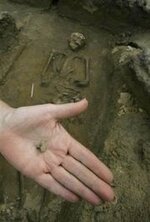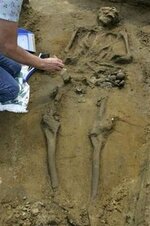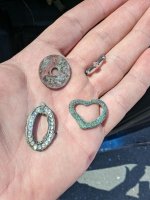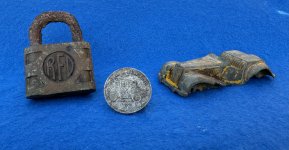Gypsy Heart
Gold Member
Photos attached
--------------------------------------------------------------------------------
http://news.yahoo.com/s/ap/20060605...2BFeQoB;_ylu=X3oDMTBiMW04NW9mBHNlYwMlJVRPUCUl
Skeletons found at Army Ranger site By CHRIS CAROLA, Associated Press Writer
Mon Jun 5, 2:02 PM ET
FORT EDWARD, N.Y. - A husband and wife team of amateur archaeologists have unearthed human skeletons, believed to be about 250 years old, at a burial site here on the Hudson River island that's considered the birthplace of today's U.S. Army Rangers.
Richard and JoAnne Fuller said it's very likely the remains found on private property date back to the French and Indian War, when Rogers' Rangers earned a place in American military lore while operating out of Fort Edward. The couple said the skeletons appear to be buried in an unmarked cemetery that doesn't appear on any colonial or contemporary maps. No other cemeteries are known to have existed on the island over the past 200 years.
"Everyone knows there's something on Rogers Island. Nobody knew where the cemetery was," said Richard Fuller as he showed a reporter the gravesites last week.
He said buttons found among the bones could give clues to whether the remains are those of some of the 15,000 soldiers and civilians who lived here in the late 1750s, when Fort Edward was the largest British military outpost in North America. It was also the base of operations for the guerrilla fighters known as Rogers' Rangers.
"Are they red coats? Are they Rangers? Are they colonial militia? Are they Native Americans enlisted in the service of the king? Were they blacks? Were they camp followers?" Richard Fuller said.
The Fullers said the discovery may have solved a mystery that has perplexed professional and amateur archaeologists for decades. Many have tried to locate the final resting place of the hundreds of soldiers knoSwn to have been buried here during the French and Indian War. Some died of battle wounds, but most are believe to have succumbed to illness or diseases such as small pox.
However, there are concerns that the Fullers' activities could jeopardize what one archaeologist called "quite a significant discovery."
"You don't just rush out there and start digging because you think it's interesting," said David Starbuck, who spent more than a decade conducting extensive excavations on Rogers Island and at nearby sites but didn't uncover any cemeteries. "It's important to proceed very cautiously."
While he and his wife aren't professional archaeologists, Richard Fuller said they're "well-versed in archaeology techniques" from their previous work with an Albany-area archaeological firm. The Fullers and some friends are painstakingly excavating the graves, removing dirt layer by layer using garden hoes, paint brushes and dental tools.
There are no plans to give professional archaeologists access to the site, although Richard Fuller said he has talked with an anthropologist about having the skeletons analyzed and studied.
Their work at the site is being questioned by some local officials who have been at odds with the couple over development plans for the island.
"It's certainly a major concern," said Town of Fort Edward Supervisor Merrilyn Pulver, adding that "all digging should cease immediately."
Most of Rogers Island, named for French and Indian War hero Maj. Robert Rogers, is private land owned by Frank Nastasi, a retired Long Island construction executive. He owns 33 acres on the 42-acre island, including the site where the skeletons were found. Nastasi is a fellow French and Indian War buff and Rogers' Rangers aficionado, said Richard Fuller, who works for Nastasi as caretaker of the Rogers Island property.
Nastasi has abandoned plans to build a marina and hotel on the island and is instead considering building a park dedicated to Rogers and the Rangers, or selling the site to New York state, which is eyeing the parcel as a possible park.
It was on the island, in 1757, where Rogers wrote his "Rules of Ranging," a manual on guerrilla warfare that became a blueprint for modern Army Ranger fighting tactics. His original 28 rules have been boiled down over the years into the 19 "Standing Orders" taught to today's Army commandos.
Fuller said he discovered the first skeleton late last fall while looking for other artifacts, and reported the find to local police. Village Police Chief Walter Sandford said the county coroner's office determined the remains were of a historical nature and not from a recent crime.
The burial site was protected by several feet of dirt dredged from the river 90 years ago and deposited on the island. Nastasi had the dirt removed several years ago, Richard Fuller said.
In one of the uncovered graves, a full skeleton lay on its back, its hands folded on its pelvis. The skull, which contained a full set of teeth, was caved in on the left side. Other partial skeletons were lined up in 18-inch-deep plots nearby, with another set off a few feet away. Blue tarps covered the graves to protect the remains from the elements.
JoAnne Fuller has given the remains names such as Caleb and Sammy, taken from the actual colonial militia rosters the Fullers have among the extensive French and Indian War collection that fills their nearby home.
"You always read about the heroes," said JoAnne Fuller, 54, a former tourism director for Washington County. "You never read about the regular soldiers."
___
--------------------------------------------------------------------------------
http://news.yahoo.com/s/ap/20060605...2BFeQoB;_ylu=X3oDMTBiMW04NW9mBHNlYwMlJVRPUCUl
Skeletons found at Army Ranger site By CHRIS CAROLA, Associated Press Writer
Mon Jun 5, 2:02 PM ET
FORT EDWARD, N.Y. - A husband and wife team of amateur archaeologists have unearthed human skeletons, believed to be about 250 years old, at a burial site here on the Hudson River island that's considered the birthplace of today's U.S. Army Rangers.
Richard and JoAnne Fuller said it's very likely the remains found on private property date back to the French and Indian War, when Rogers' Rangers earned a place in American military lore while operating out of Fort Edward. The couple said the skeletons appear to be buried in an unmarked cemetery that doesn't appear on any colonial or contemporary maps. No other cemeteries are known to have existed on the island over the past 200 years.
"Everyone knows there's something on Rogers Island. Nobody knew where the cemetery was," said Richard Fuller as he showed a reporter the gravesites last week.
He said buttons found among the bones could give clues to whether the remains are those of some of the 15,000 soldiers and civilians who lived here in the late 1750s, when Fort Edward was the largest British military outpost in North America. It was also the base of operations for the guerrilla fighters known as Rogers' Rangers.
"Are they red coats? Are they Rangers? Are they colonial militia? Are they Native Americans enlisted in the service of the king? Were they blacks? Were they camp followers?" Richard Fuller said.
The Fullers said the discovery may have solved a mystery that has perplexed professional and amateur archaeologists for decades. Many have tried to locate the final resting place of the hundreds of soldiers knoSwn to have been buried here during the French and Indian War. Some died of battle wounds, but most are believe to have succumbed to illness or diseases such as small pox.
However, there are concerns that the Fullers' activities could jeopardize what one archaeologist called "quite a significant discovery."
"You don't just rush out there and start digging because you think it's interesting," said David Starbuck, who spent more than a decade conducting extensive excavations on Rogers Island and at nearby sites but didn't uncover any cemeteries. "It's important to proceed very cautiously."
While he and his wife aren't professional archaeologists, Richard Fuller said they're "well-versed in archaeology techniques" from their previous work with an Albany-area archaeological firm. The Fullers and some friends are painstakingly excavating the graves, removing dirt layer by layer using garden hoes, paint brushes and dental tools.
There are no plans to give professional archaeologists access to the site, although Richard Fuller said he has talked with an anthropologist about having the skeletons analyzed and studied.
Their work at the site is being questioned by some local officials who have been at odds with the couple over development plans for the island.
"It's certainly a major concern," said Town of Fort Edward Supervisor Merrilyn Pulver, adding that "all digging should cease immediately."
Most of Rogers Island, named for French and Indian War hero Maj. Robert Rogers, is private land owned by Frank Nastasi, a retired Long Island construction executive. He owns 33 acres on the 42-acre island, including the site where the skeletons were found. Nastasi is a fellow French and Indian War buff and Rogers' Rangers aficionado, said Richard Fuller, who works for Nastasi as caretaker of the Rogers Island property.
Nastasi has abandoned plans to build a marina and hotel on the island and is instead considering building a park dedicated to Rogers and the Rangers, or selling the site to New York state, which is eyeing the parcel as a possible park.
It was on the island, in 1757, where Rogers wrote his "Rules of Ranging," a manual on guerrilla warfare that became a blueprint for modern Army Ranger fighting tactics. His original 28 rules have been boiled down over the years into the 19 "Standing Orders" taught to today's Army commandos.
Fuller said he discovered the first skeleton late last fall while looking for other artifacts, and reported the find to local police. Village Police Chief Walter Sandford said the county coroner's office determined the remains were of a historical nature and not from a recent crime.
The burial site was protected by several feet of dirt dredged from the river 90 years ago and deposited on the island. Nastasi had the dirt removed several years ago, Richard Fuller said.
In one of the uncovered graves, a full skeleton lay on its back, its hands folded on its pelvis. The skull, which contained a full set of teeth, was caved in on the left side. Other partial skeletons were lined up in 18-inch-deep plots nearby, with another set off a few feet away. Blue tarps covered the graves to protect the remains from the elements.
JoAnne Fuller has given the remains names such as Caleb and Sammy, taken from the actual colonial militia rosters the Fullers have among the extensive French and Indian War collection that fills their nearby home.
"You always read about the heroes," said JoAnne Fuller, 54, a former tourism director for Washington County. "You never read about the regular soldiers."
___







